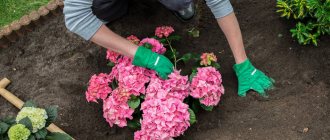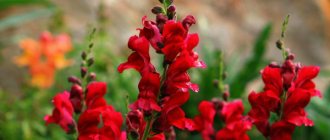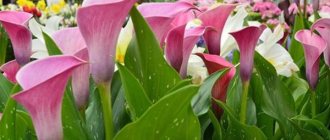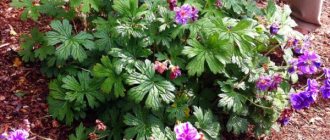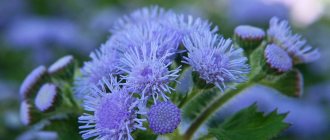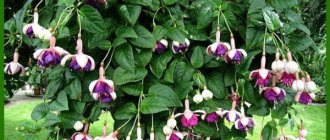Phacelia belongs to herbaceous perennial and annual plants and belongs to the borage family. North and South America are considered its cradle. Today, the plant is distributed throughout the world. The reason for this was a lot of useful and necessary properties, as well as the beautiful appearance of phacelia.
Author of the article
Eduard Dmitriev
Florist and lover of indoor and garden plants.
In a short time, phacelia brings back to life the most degraded soil, restoring fertility and balance of substances. The phacelia flower is a honey plant, and the honey obtained from it has unique properties.
The name for the genus comes from the structure of the inflorescence. Phacelia translated from Greek means “bundle”. And on top of everything else, growing phacelia does not require any special knowledge or skills; even a novice gardener can handle it.
What is phacelia, its green manure properties
Tansy-leaved phacelia fully exhibits the qualities of green manure.
Therefore, let us consider the properties of the plant in relation to this species. Translated from ancient Greek , the word “phacelia” means “bundle” . The height of the plant reaches one meter. The similarity of the leaves in shape to tansy leaves formed the basis of the name.
The peduncles are shaped like spikes and consist of small flowers, no more than three centimeters in diameter. On average, the number of such ears on one plant ranges from 30 to 40 pieces. It all depends on the growing conditions. During flowering, phacelia emits a pleasant aroma, which attracts bees.
A cascading type of flowering is characteristic. It consists of blooming buds one after another. The lifespan of one flower is about two days. Thus, during the entire growing season, the plant has flowers, buds, and the stage of seed formation is observed.
About 40 days should pass before flowering begins. If you do not mow the phacelia at this stage of development, then for another eight weeks you can admire the continuation of flowering.
Advantages and disadvantages of phacelia, benefits and harm to soil and plants. Is it true that it is considered a universal green manure?
Phacelia, as a green manure, is used even on the most problematic soils. It is planted on soils with a high content of clay or sand.
Here is how green manure affects soil intended for growing crops:
- the soil becomes loose, air penetrates the upper layers of the soil, saturating the root system with oxygen;
- soil fertility increases. This occurs due to an increase in the amount of useful elements in a form that is easily accessible to plants;
- the acid-base balance of the soil is normalized.
Common types
The buds of Phacelia tansy emit a pleasant honey aroma.
There are from 50 to 80 varieties of phacelia. In our latitudes the following are grown:
- Phacelia tanacetifolia. This is an annual variety, reaching a height of 1 m. Blue flowers form above the oval, jagged leaves. They are a spike-shaped inflorescence in the shape of a curl. The diameter of the petals is 2 cm.
Phacelia bell-shaped is famous for its beautiful blue flowers. - Bell-shaped phacelia (Phacelia campanularia). The culture has erect stems, their height is up to 0.25 m. They are distinguished by their fleshiness and fragility. The leaves have a greenish-gray tint. The flowers are bell-shaped, bright purple in color, 3 cm in diameter. They begin to bloom in early June. This species is divided into several varieties: Californian - has blue flowers, diameter - up to 30 mm; Blue Bonnet - flowers are bright blue, the bush grows up to 40 cm in height.
- Phacelia congesta. The shoots reach a height of 50 cm. The culture has soft, jagged leaves with pile. Flowering lasts from June to September, the buds are a rich blue color.
Phacelia twisted has blue flowers collected in spiral-shaped inflorescences.
For which crops is phacelia suitable?
Phacelia is known for its versatility. It can be used to improve land plots after any crop. After phacelia, you can grow vegetables, grains, and other types of plants. For example, cruciferous crops cannot be planted after mustard. For phacelia there are no restrictions in this regard.
Phacelia, like green manure, intensively and quickly produces succulent leaves and stems. Does not require mandatory incorporation into the soil. You can limit yourself to trimming the roots with a flat cutter and leave them on the soil surface.
Sowing rules
You need to take at least 150 g of seeds per hundred square meters. You can purchase them both in any online stores and on the market. There will be no problems with the purchase. If planting material is purchased via the Internet, it is very important to discuss the possibility of exchange or return with the seller in advance. Sometimes it happens that seeds have been in storage for a long time, become infected with fungus or become moldy. Then they either won’t hatch at all or will sprout poorly. Your energy, money and time will be wasted. Of course, no self-respecting company will sell such a product, since it will simply lose customers. But if this happens, the seller must replace the defective product. The germination of seeds and the future harvest depend on the quality of the raw materials.
Stratification is not necessary, since the seed material is characterized by high germination. The plant should always be sown in a permanent place, as it does not tolerate transplantation.
Subsequence:
- Take clean coarse sand and mix it with the seeds to make it easier to sow evenly. The seeding material is dark in color, so it is difficult to distinguish it on the surface of the earth, but sand helps to see where the soil is sown and where it is not.
- Prepare the soil by loosening it slightly to a maximum depth of 5 cm.
- Scatter the seeds, trying to do it very evenly, and plant them in the soil to a depth of about 3 cm. You can also sow in rows, at a distance of about 10 cm from each other.
- If the weather is dry, water the soil.
Now all that remains is to wait for the sprouts to appear. This may take up to 2 weeks. After 6–7 weeks, the grass needs to be cut and embedded in the ground.
As for planting seeds in the soil, some gardeners claim that they can do just fine without this step. The seed germinates just fine. Reviews confirm that the structure of even heavy loams becomes several times higher, many worms appear, and the number of weeds decreases. The only negative is that the price is not quite affordable in comparison with the same mustard. But collecting the seeds yourself is quite problematic, since they ripen at different times. On the lower part of the inflorescence they ripen earlier, while the upper ones are still immature. If you wait for the seeds at the top of the shoot to ripen, the lower ones will overripe and fall off.
Reviews and advice from gardeners
I use phacelia to “clean” the garden of weeds and diseases.
Helps get rid of late blight that affected tomatoes and potatoes. It is less suitable as a fertilizer, but the soil becomes loose and the acidity goes away. I noticed that there was less wheatgrass. Vitaly. Moscow region.
I would like to warn novice gardeners against the mistakes they make by not following mowing deadlines.
If the phacelia is already blooming profusely, then the stems will decompose slowly. There's no point. You should start mowing at the first signs of flowering. The stems are not yet hard, you can chop them further. If you missed the moment, it is better to put the remains in the compost pit. Leave only the roots on the field. After two weeks they completely rot. Anna. Tula city.
I sow phacelia together with other green manures.
I especially like the mixture with legumes. Phacelia, as green manure, does not contain enough nitrogen. Joint planting with other green manures smooths out this disadvantage. After such soil preparation, any vegetables can be grown. It is better to plant phacelia densely. Rare crops immediately bend to the ground. Natalia. Rostov region.
I try to sow phacelia every year after harvest.
Sometimes I plant together with mustard, but more often I just alternate these crops. I do not recommend leaving it until flowering. This is a powerful honey plant. A huge number of insects will appear on the site. It is especially unpleasant when wasps are buzzing everywhere. Moreover, they start nests, it is difficult to get rid of such a neighborhood. Having had this experience, I no longer bring it to the flowering stage. Sergey. Moscow region
I tried different green manures. Once I sowed mustard. Everything was fine, but then aphids came. There are no such problems with phacelia. Green manure helps get rid of weeds under trees. We have a large garden, and it’s not always possible to weed everything. I leave the phacelia until it blooms. The inflorescences are very beautiful. The bouquet can last more than a week. An armful of phacelia looks great.
There is no need to be afraid that the plant will spread throughout the garden.
The germination rate of self-sowing seeds is very low. Still have to buy more. They are not cheap. Olga. Severodvinsk.
Phacelia care
Phacelia is considered a tenacious and picky crop. It is characterized by resistance to drought; watering will only be needed in the event of a prolonged lack of precipitation - if the soil surface cracks. In the initial 2-3 weeks of seedling growth, weeding and loosening of the soil will be required. Then this procedure will no longer be required.
To improve flowering and rapid growth, it is recommended to fertilize the crop twice a season using universal mineral complexes. The buds open a month after sowing.
Seeds begin to be collected after half of the achenes have turned brown. The main thing is not to miss this moment, since the ripened achenes open naturally.
Features of reproduction
Cultivation is carried out immediately in open soil. Young seedlings can withstand sub-zero temperatures (not lower than -9°C). You can sow the plant for the winter; this is done in November (but before the onset of frost). In spring, sowing is allowed from mid-March until the second half of April.
Phacelia can be planted anywhere on your site, the plant takes root well, the main thing is to water it in a timely manner.
In July you can sow the plant a second time. Since the seeds are small, they are used to make a mass based on sand and sawdust. 100 g of seed is enough for a 60-80 m² plot. The distance between seedlings is 4-7 cm.
Description of the plant
Phacelia is grown as an annual crop. Its height is 25-100 cm. The stems are colored reddish or green, against which beautiful blue or lilac flowers look advantageous. The flowers are bell-shaped with five petals and stamens with white anthers protruding from the dome.
The American continents are considered to be the homeland of phacelia. The natural habitat explains the plant's drought resistance.
The flowers are not striking in their size. They are rather small than large and are 3-6 mm in diameter. The buds form racemose inflorescences, which contain 8-12 flowers.
The leaf blades of the plant are oval-shaped and green. There are teeth along the edge of the sheet. The leaves are attached alternately to the stem on short petioles. There are glandular fibers on the stems and leaves.
The flowering period for phacelia occurs 30-40 days after sowing. After wilting, a box with seeds forms in place of the bud. The contents of the fruit box are filled with small seeds. Seed ripening occurs unevenly. The seed remains viable for 4 years. Rapid development of the plant is noted. But if the plant has immunity to dry weather, then the first frost will lead to its death.
The plant can boast that it is capable of self-reproduction. Thanks to self-seeding, young plants grow from vegetative shoots two years later. Such plants bloom in early summer.
Use in the garden
By planning planting in several stages, you can achieve continuous flowering “from snow to snow.” Decorative forms are planted in a mixed flower bed, along the border, among stones and boulders. They can be planted between fruit plants to decorate and protect the garden. Phacelia looks very beautiful in flowerpots, as an hanging plant for a balcony and veranda. It is combined with calendula, flax, rudbeckia, lavender, eschscholzia, and atrium. The seeds of this beauty are added to the mixture for the Moorish lawn.
Agricultural Application
There are three areas of application of Phacelia campanulate in agriculture:
- forerunner and protector of other cultures;
- forage plant;
- green manure
Phacelia Campanularia growing on the site performs sanitary functions, reducing the number of parasites and reducing the content of harmful microflora. This plant can be used to create protective conditions when placing seedlings in the ground. In this case, phacelia bushes create a favorable microclimate that protects young shoots from the heat of the day and the cold of the night.
The aroma of Phacelia Campanularia attracts pollinating insects and, on the contrary, repels pests. This plant can also reduce the number of weeds.
The green manure properties of phacelia are especially valuable. According to experienced gardeners, dense sowing of one hundred square meters of land with this plant has a fertilizing effect that replaces the application of three hundred kilograms of manure. The advantage of using phacelia to improve soil fertility is also its simplicity. You just need to sow the area several times during the season, and the fast-growing shoots, dying, will themselves turn into fertilizer.
Phacelia Californian bell: care and growing from seeds
Phaselia is a genus that combines annual and perennial plants, as well as a biennial form. Currently, up to eighty species of this herbaceous plant from the waterleaf family (Hydrophyllacea) are known. Its Latin name comes from the Greek φάκελος, which means “ligament”. The plant's habitat is on both American continents.
On the territory of Russia, one of the species is cultivated as a honey-bearing green manure, and another as a decorative annual flower.
Features of seed collection
The fastest and most proven method of propagation is seeds. Minimum amount of hassle with high productivity.
Before you properly collect phacelia seeds you will need:
- scissors or pruning shears;
- container for placing inflorescences (basin or basket);
- gloves. Sharp dead wood can cause injury.
After making sure that the spikelets are ready, you can begin the procedure. “Umbrellas” with part of the stem are cut off and placed in a container. After processing the entire area, the inflorescences undergo peeling. It is recommended not to combine processes - some of the material will be lost. Within the homestead area, the event is carried out manually. Industrial volumes are processed with special agricultural machinery.
Carry out work in dry weather. Rain and high humidity spoil the quality of raw materials. If weather conditions prevent natural processing, the picked “cobs” should be placed in a dry, ventilated room to remove excess moisture.
The final stage is final drying. To do this, prepare a platform under a canopy, onto which the seeds are poured in a thin layer. It is appropriate to use a fine mesh as a frame. Avoid exposure to direct sunlight. Optimal conditions are placement in partial shade. The material is periodically mixed for uniform drying. If the procedure is carried out indoors, ventilation is provided. The lack of fresh air negatively affects the quality, causing rot. The finished product is poured to remove any remaining bolls and husks.
